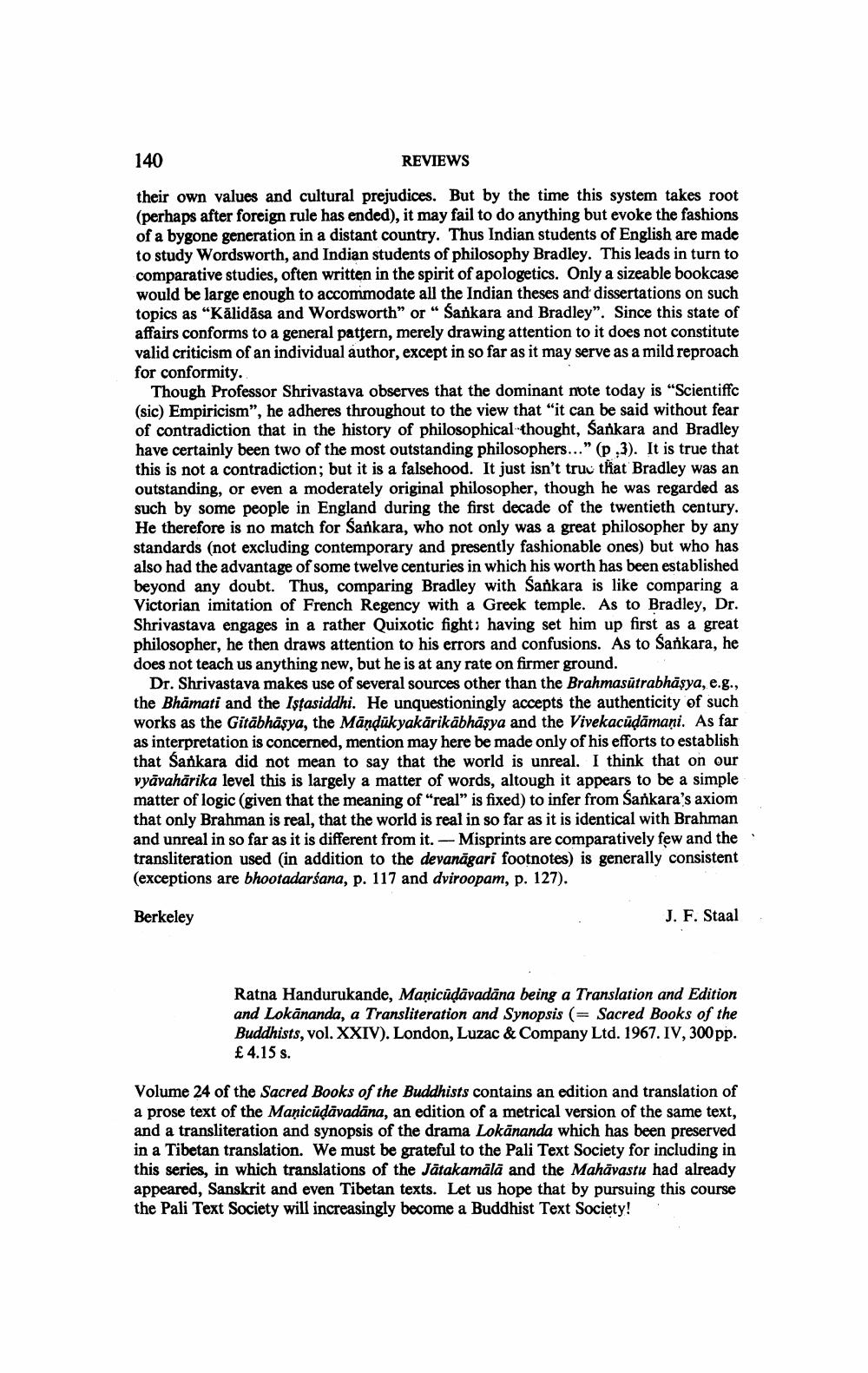Book Title: Reviews Of Different Books Author(s): Publisher: View full book textPage 4
________________ 140 REVIEWS their own values and cultural prejudices. But by the time this system takes root (perhaps after foreign rule has ended), it may fail to do anything but evoke the fashions of a bygone generation in a distant country. Thus Indian students of English are made to study Wordsworth, and Indian students of philosophy Bradley. This leads in turn to comparative studies, often written in the spirit of apologetics. Only a sizeable bookcase would be large enough to accommodate all the Indian theses and dissertations on such topics as "Kalidasa and Wordsworth" or " Sankara and Bradley". Since this state of affairs conforms to a general pattern, merely drawing attention to it does not constitute valid criticism of an individual author, except in so far as it may serve as a mild reproach for conformity. Though Professor Shrivastava observes that the dominant note today is "Scientiffc (sic) Empiricism", he adheres throughout to the view that "it can be said without fear of contradiction that in the history of philosophical thought, Sankara and Bradley have certainly been two of the most outstanding philosophers..." (p ,3). It is true that this is not a contradiction; but it is a falsehood. It just isn't truc that Bradley was an outstanding, or even a moderately original philosopher, though he was regarded as such by some people in England during the first decade of the twentieth century. He therefore is no match for Sankara, who not only was a great philosopher by any standards (not excluding contemporary and presently fashionable ones) but who has also had the advantage of some twelve centuries in which his worth has been established beyond any doubt. Thus, comparing Bradley with Sankara is like comparing a Victorian imitation of French Regency with a Greek temple. As to Bradley, Dr. Shrivastava engages in a rather Quixotic fight: having set him up first as a great philosopher, he then draws attention to his errors and confusions. As to Sankara, he does not teach us anything new, but he is at any rate on firmer ground. Dr. Shrivastava makes use of several sources other than the Brahmasutrabhasya, e.g., the Bhamati and the Istasiddhi. He unquestioningly accepts the authenticity of such works as the Gitabhasya, the Mandukyakarikabhasya and the Vivekacudamani. As far as interpretation is concerned, mention may here be made only of his efforts to establish that Sankara did not mean to say that the world is unreal. I think that on our vyavaharika level this is largely a matter of words, altough it appears to be a simple matter of logic (given that the meaning of "real" is fixed) to infer from Sankara's axiom that only Brahman is real, that the world is real in so far as it is identical with Brahman and unreal in so far as it is different from it. - Misprints are comparatively few and the transliteration used (in addition to the devanagari footnotes) is generally consistent (exceptions are bhootadarsana, p. 117 and dviroopam, p. 127). Berkeley J. F. Staal Ratna Handurukande, Manicudavadana being a Translation and Edition and Lokananda, a Transliteration and Synopsis (= Sacred Books of the Buddhists, vol. XXIV). London, Luzac & Company Ltd. 1967. IV, 300 pp. PS 4.15 s. Volume 24 of the Sacred Books of the Buddhists contains an edition and translation of a prose text of the Manicudavadana, an edition of a metrical version of the same text, and a transliteration and synopsis of the drama Lokananda which has been preserved in a Tibetan translation. We must be grateful to the Pali Text Society for including in this series, in which translations of the Jatakamala and the Mahavastu had already appeared, Sanskrit and even Tibetan texts. Let us hope that by pursuing this course the Pali Text Society will increasingly become a Buddhist Text Society!Page Navigation
1 2 3 4 5 6 7 8 9 10 11 12 13 14 15
